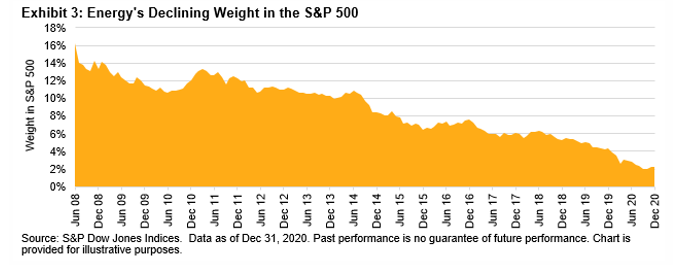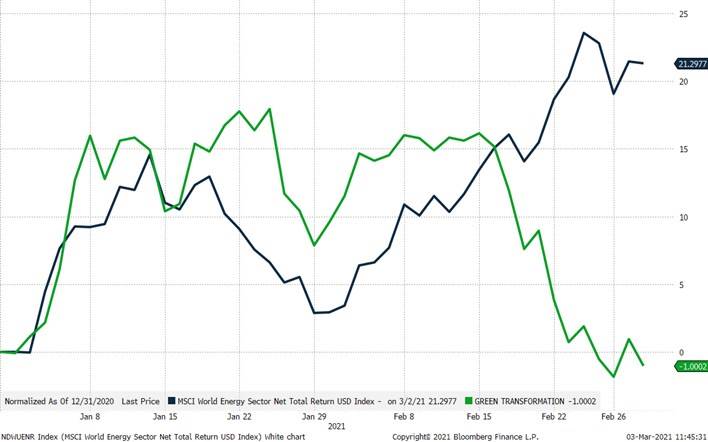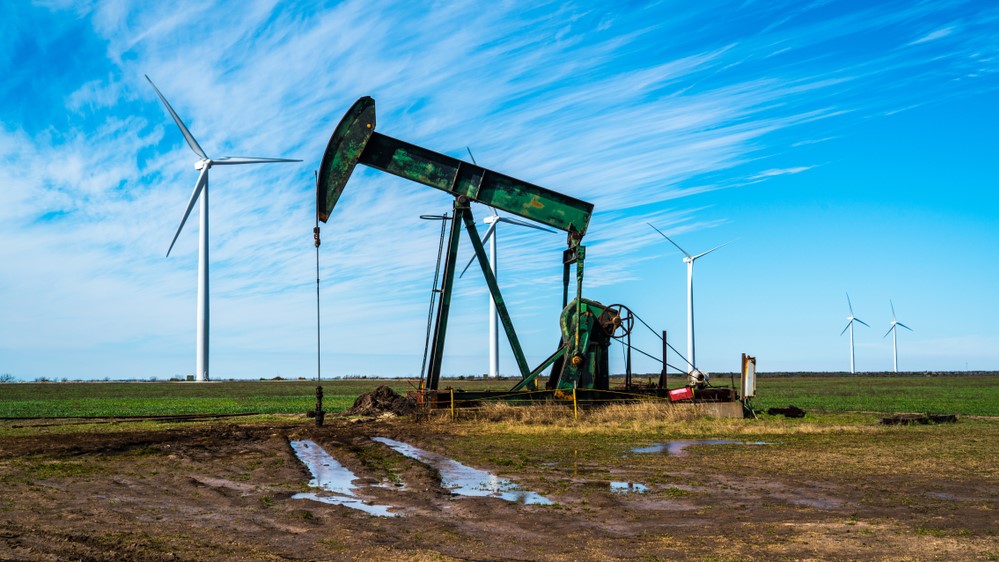Energy ETFs have burned brightly in recent months, as hopes of a pandemic recovery and a return-to-value have seen prices and equities tick upwards from their respective lows in 2020.
Evidencing this is the ongoing investor surge into energy strategies. The $938.7m Invesco Bloomberg Commodities UCITS ETF (CMOD), for instance, has seen $323m inflows over the past three months, as at 19 February, according to data from ETFLogic.
Likewise, the $1.1bn iShares STOXX 600 Oil & Gas UCITS ETF (EXH1) saw inflows of $308m during the same three-month period, while the $571m iShares S&P 500 Energy Sector UCITS ETF (IUES) has pulled in $247m.
Not only have these products been popular among investors, but they have also performed well since the switch to cyclical equities in late 2020. While CMOD returned 14.1% and EXH1 returned 7%, IUES took the crown with returns of 25.4%.
Paul Jackson, global head of asset allocation research at Invesco, said the bullish numbers come in response to a favourable outlook for cyclical assets over the next 12 months, backed by a global economic recovery and accommodative central bank policies.
Equal weight ETF inflows surge as investors bet on cyclical shift
Jackson said: “[We] are overweight industrial commodities within our model asset allocation, including energy.
“Though, Brent Crude is currently around $60 a barrel, which we consider to be the upper end of its normal (non-bubble) range, we suspect cyclical momentum could push it higher.”
The reason for IEUS posting such exceptional inflows and returns versus its global and European peers is simple: US energy equities have declined so significantly in prevalence over the past decade, that they entered this period of recovery from a very low base.

Responding to this, Matt Brennan, head of passive portfolios at AJ Bell, said they had added IEUS to its allocation on 18 February, and had seen the decision bear fruit within the first week.
“We have positioned ourselves towards equities with a more value tilt for example – we bought IEUS on Thursday, and it has already outpaced the markets by around 7%. I think others are taking similar views and it is driving the trends.” Brennan said.
Having suffered due to reduced energy demand, dividend cuts, favourable conditions for renewables, and divestment by ESG-minded investors in 2020, oil prices bottomed out last April, and FTSE-listed oil equities hit their respective two-decade nadirs last October. The question that now needs to be answered is – how long will the current energy recovery last?
With the price of WTI and Brent Crude rising by between 14-15% apiece during February, Toby Dudley-Smith, head of passive sales at DWS, believes the rally will continue through this year.

“As oil prices continue their recovery, we expect to see growing investor demand for energy names as we move further into 2021.” Dudley-Smith said.
Challenges in the pipeline
In contrast, Invesco’s Jackson said some negatives remain in place and while oil prices and volumes may push higher, the company retains its neutral stance on the energy sector.
Jackson continued: “To feel more confident, we would need to see the oil price push a lot higher, along with signs that dividends will be increased. Also, it would be good to see the sector addressing the concerns of ESG minded investors.”
Other risk factors include potential delays to the coronavirus pandemic recovery and the introduction of new restrictions weighing on demand from travel and industry. Also, amid recent coverage of inflationary pressure, investors ought to remain mindful of central bank policy and how institutions weigh up asset purchases for the COVID-19 recovery versus inflation targets.
Inflation: The biggest risk facing investors over the next year
Unsurprisingly, though, the main point of concern is the speed and nature of the energy transition, under a Joe Biden presidency, the European Green New Deal, and the COP 26 summit due to be held in November.
As such, Jackson stressed: “In our opinion, any recovery in the oil price will be cyclical rather than secular. We expect the demand for oil to dwindle in real terms as the world moves away from it as a source of energy.”
Supporting this, Morgane Delledonne, director of research at Global X ETFs, said whether or not 2050 emissions targets are met, the company’s view is such commitments will translate into “significant investments” in the CleanTech industry.
With renewables making up just 11% of the global energy mix, the international community is a long way off achieving the 28% target set by emissions-warming models.
Delledonne continued: “However, we believe that the rise of ESG and sustainability considerations in investors’ decision making will pressure energy companies to clarify their business strategies for an energy transition, and to communicate regularly on their contributions and efforts to reducing carbon emissions.
“As a result, we expect an acceleration of clean energy capital expenditures over the medium-term.”
While the renewables transition is broadly accepted as conventional wisdom, there are some nuances that need to be considered about the role of oil and gas – and energy companies – going forwards.
For instance, the point has been made that 9 million consumers deferred car replacements during the pandemic, yet sales and forward-looking demand for electric vehicles remain strong. This will be a concern for oil producers, given that road transportation accounts for approximately 60% of oil demand, Delledonne added.
Old energy still has power
However, the strength of the 2021 economic recovery will likely take precedence over its sustainability credentials, and thus 'black' energy will be favoured over 'green' energy as the primary fuel for a period of rising production and consumption.

Furthermore, Stacey Morris, director of research at MLP provider and energy benchmarking business at Alerian, said the role of fossil fuels – especially natural gas – will remain crucial even after the post-pandemic recovery.
Morris said: “While there is an emphasis in developed countries on a green recovery and electrification, fossil fuels, particularly natural gas, have an important role to play in providing energy solutions for other parts of the world and indeed improving the quality of life.”
Echoing her views Delledone said: “The outlook for oil and gas is likely to deteriorate faster in the developed economies relative to developing economies given that the former have the resources to develop the infrastructures required to further support the energy transition to renewables.”
With that being said, the challenge of giving up fossil fuels remains a global challenge concerning all countries. Indeed, there is an ongoing debate about whether electric batteries or hydrogen fuel cells are the preferred choice for future travel, and what the logistics would look like for implementing the necessary infrastructure for either, on a national scale.
Likewise, while expanding the roll-out of renewables over the past decade, demand for coal increased by 75% between 2000 and 2013, Morris said. Also, despite being a leading light in renewable power generation, the UK is debating whether to open its first coal coking deep mine in three decades, and still relies on natural gas for 40% of its electricity generation, and most domestic heating.
Alongside the continued shift to gas – as the ‘greener’ fossil fuel – Jackson predicted oil majors will begin deriving a more meaningful portion of their revenues from their clean energy acquisitions and will eventually become leaders in the sector.
“We suspect that the current energy giants will also dominate the clean energy market,” he concluded.
In summary, energy ETFs will benefit as oil and gas power the economic recovery. Also, while the energy transition may be underway, we should neither jump the gun regarding when, where, or how this will happen, nor should we assume that energy blue chips will merely bow out as fossil fuels subside in years to come.








